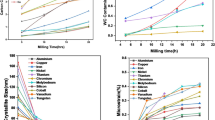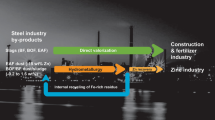Abstract
The size, morphology, and chemical composition of particles deposited in the lungs of two nickel refinery workers were studied by scanning and transmission electron microscopy. The particles were extracted from the lung tissue by low-temperature ashing or by dissolution in tetramethylammonium hydroxide. The suitability of both sample preparation techniques was checked with reference materials. Both approaches lead to Fe-rich artifact particles. Low-temperature ashing leads to oxidation of small (diameter < 2 μm) metallic Ni and Ni sulfide particles, dissolution in tetramethylammonium hydroxide to removal of sulfate surface layers. Silicates and alumosilicates are the most abundant particle groups in the lungs of both subjects. From the various metal-dominated particle groups, Ni-rich particles are most abundant followed by Fe-rich and Ti-rich particles. Ni appears to be present predominantly as an oxide. Pure Ni metal and Ni sulfides were not observed. The presence of soluble Ni phases was not investigated as they will not be preserved during sample preparation. Based on their spherical morphology, it is estimated that a large fraction of Ni-rich particles (50–60 % by number) as well as Fe-rich and Cu-rich particles (27–45 %) originate from high-temperature processes (smelting, welding). This fraction is much lower for silicates (3–5 %), alumosilicates (1–2 %), and Ti-rich particles (9–11 %). The absence of metallic Ni particles most likely results from low exposure to this species. The absence of Ni sulfides may be either ascribed to low exposure or to fast clearance.





Similar content being viewed by others
References
Klein C, Costa M (2015) Nickel. In: Nordberg GF, Fowler BA, Nordberg M (eds) Handbook on the toxicology of metals, volume II, chapter 48, 4th edn. Elsevier, Amsterdam
Nickel Institute (2008) Safe use of nickel in the workplace, 3rd edn. Available at: www.nickelinstitute.org/NiPERA/WorkplaceGuide.aspx
Muñoz A, Costa M (2012) Elucidating the mechanisms of nickel compound uptake: a review of particulate and nano-nickel endocytosis and toxicity. Toxicol Appl Pharmacol 260:1–16
Thomassen Y, Nieboer E, Ellingsen D, Hetland S, Norseth T, Odland JO, Romanova N, Chernova S, Tchachtchine VP (1999) Characterisation of workers’ exposure in a Russian nickel refinery. J Environ Monit 1:15–22
Höflich BLW, Wentzel M, Ortner HM, Weinbruch S, Skogstad A, Hetland S, Thomassen Y, Chaschin VP, Nieboer E (2000) Chemical composition of individual aerosol particles from working areas in a nickel refinery. J Environ Monit 2:213–217
Weinbruch S, van Aken P, Ebert M, Thomassen Y, Skogstad A, Chashchin VP, Nikonov A (2002) The heterogeneous composition of working place aerosols in a nickel refinery: a transmission and scanning electron microscope study. J Environ Monit 4:344–350
Vaktskjold A, Talykova LV, Chashchin VP, Nieboer E, Thomassen Y, Odland JO (2006) Genital malformations in newborns of female nickel-refinery workers. Scand J Work Environ Health 32:41–50
Chashschin VP, Artunina GP, Norseth T (1994) Congenital defects, abortion and other health effects in nickel refinery workers. Sci Total Environ 148:287–291
Vaktskjold A, Talykova LV, Chashchin VP, Odland JO, Nieboer E (2007) Small-for-gestational-age newborns of female refinery workers exposed to nickel. Int J Occup Med Environ Health 20:327–338
Vaktskjold A, Talykova LV, Chashchin VP, Odland JO, Nieboer E (2008) Spontaneous abortions among nickel-exposed female refinery workers. Int J Environ Health Res 18:99–115
Vaktskjold A, Talykova LV, Chashchin VP, Odland JO, Nieboer E (2008) Maternal nickel exposure and congenital musculoskeletal defects. Am J Ind Med 51:825–833
Andersen I, Svenes K (2003) X-ray diffraction spectrometric analysis of nickel refinery aerosols, process materials and particulates isolated from worker lung tissues. J Environ Monit 5:202–205
Murthy L, Menden EE, Eller PM, Petering HG (1973) Atomic absorption determination of zinc, copper, cadmium, and lead in tissues solubilized by aqueous tetramethylammonium hydroxide. Anal Biochem 53:365–372
Brody AR, Hill LH (1982) Interstitial accumulation of inhaled crysotile asbestos fibers and consequent formation of microcalcifications. Am J Pathol 109:107–114
Paoletti L, Batisti D, Caiazza S, Petrelli MG, Taggi F, de Zorzi L, Dina MA, Donelli G (1987) Mineral particles in the lungs of subjects resident in the Rome area and not occupationally exposed to mineral dust. Environ Res 44:18–28
Krehula S, Musić S (2008) Influence of aging in an alkaline medium on the microstructural properties of α-FeOOH. J Cryst Growth 310:513–520
Goldstein J, Newbury D, Joy D, Lyman C, Echlin P, Lifshin E, Sawyer L, Michael J (2003) Scanning electron microscopy and x-ray microanalysis, 3rd edn. Springer, Heidelberg
Armststrong JT (1991) Quantitative elemental analysis of individual microparticles with electron beam instruments. In: Heinrich KFJ, Newbury DE (eds) Electron probe quantitation. Plenum Press, New York
Doll R (1990) Report of the International Committee on Nickel Carcinogenesis in Man. Scand J Work Environ Health 16:9–82
Ophus EM, Rode L, Gylseth B, Nicholson DG, Saeed K (1979) Analysis of titanium pigments in human lung tissue. Scand J Work Environ Health 5:290–296
Winchester JW (1984) Ambient aerosols in remote and polluted atmospheres. Nucl Inst Methods Phys Res B 3:454–461
Chen Y, Shah N, Huggins FE, Huffman GP (2005) Transmission electron microscopy investigation of ultrafine coal fly ash particles. Environ Sci Technol 39:1144–1151
Mitrofanov F (1995) Geology of the Kola Peninsula (Baltic Shield). Kola Science Centre, Apatity
Votekhovsky V, Pihlaja J (2011) Geochemistry in Khibiny mountains and Monchegorsk, Kola Peninsula, Russia (excursion guide, 25th International Applied Geochemistry Symposium 2011). Vuorimiesydistys – Finnish Association of Mining and Metallurgical Engineers, Rovaniemi
Inerle-Hof M, Weinbruch S, Ebert M, Thomassen Y (2007) The hygroscopic behaviour of individual aerosol particles in nickel refineries as investigated by environmental scanning electron microscopy. J Environ Monit 9:301–306
Hirano S, Shimada T, Osugi J, Kodama N, Suzuki KT (1994) Pulmonary clearance and inflammatory potency of intratracheally instilled or acutely inhaled nickel sulfate in rats. Arch Toxicol 68:548–554
Carvalho SMM, Ziemer PL (1982) Distribution and clearance of 63Ni administered as 63NiCl2 in the rat: intratracheal study. Arch Environ Contam Toxicol 11:245–248
Werner MA, Thomassen Y, Hetland S, Norseth T, Berge SR, Vincent JH (1999) Correlation of urinary nickel excretion with observed ‘total’ and inhalable aerosol exposures of nickel refinery workers. J Environ Monit 1:557–562
Grimsrud TK, Berge SR, Resmann F, Norseth T, Andersen A (2000) Assessment of historical exposures in a nickel refinery in Norway. Scand J Work Environ Health 26:338–345
Kuehn K, Sunderman FW (1982) Dissolution half-times of nickel compounds in water, rat serum, and renal cytosol. J Inorg Biochem 17:29–39
Sunderman FW, Hopfer SM, Knight JA, McCully KS, Cecutti AG, Thornhill PG, Conway K, Miller C, Patierno SR, Costa M (1987) Physicochemical characteristics and biological effects of nickel oxides. Carcinogenesis 8:305–313
Tanaka I, Ishimatsu S, Haratake J, Horie A, Kodama Y (1988) Biological half-time in rats exposed to nickel monosulfide (amorphous) aerosol by inhalation. Biol Trace Elem Res 17:237–246
Benson JM, Henderson RF, McClellan RO, Hanson RL, Rebar AH (1986) Comparative acute toxicity of four nickel compounds to F344 rat lung. Fundam Appl Toxicol 7:340–347
Vincent JH, Ramachandran G, Kerr SM (2001) Particle size and chemical species “fingerprinting” of aerosols in primary nickel production industry workplaces. J Environ Monit 3:565–574
Kuehn K, Fraser CB, Sunderman FW (1982) Phagocytosis of particulate nickel compounds by rat peritoneal macrophages in vitro. Carcinogenesis 3:321–326
Wilson EB (1927) Probable inference, the law of succession, and statistical inference. J Am Stat Assoc 22:209–212
Gylseth B, Baunan RH, Bruun R (1981) Analysis of inorganic fiber concentrations in biological samples by scanning electron microscopy. Scand J Work Environ Health 7:101–108
Acknowledgments
We would like to thank Gabriele Gorzawski for focussed ion beam investigations.
Ethical approval
The manuscript was evaluated by the regional ethical committee of Norway (REK nord) at the University of Tromsø, and it was concluded by this committee that the study does not require an ethical approval.
Conflict of interest
The authors declare that they have no competing interests.
Author information
Authors and Affiliations
Corresponding author
Electronic supplementary material
Below is the link to the electronic supplementary material.
ESM 1
Instrumental parameters, particle classification criteria and results of treatment of standard materials (PDF 121 kb)
Rights and permissions
About this article
Cite this article
Küpper, M., Weinbruch, S., Skaug, V. et al. Electron microscopy of particles deposited in the lungs of nickel refinery workers. Anal Bioanal Chem 407, 6435–6445 (2015). https://doi.org/10.1007/s00216-015-8806-z
Received:
Revised:
Accepted:
Published:
Issue Date:
DOI: https://doi.org/10.1007/s00216-015-8806-z




